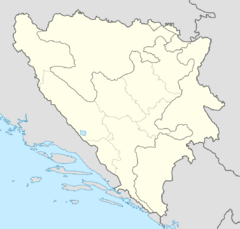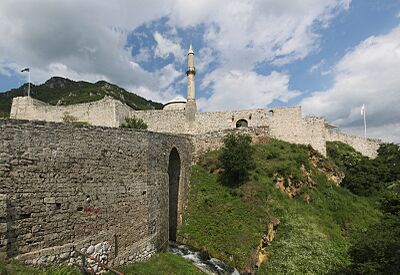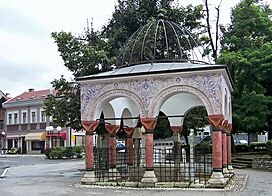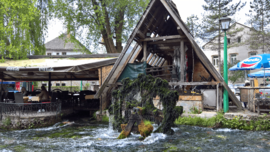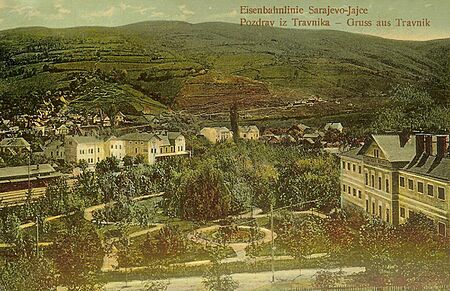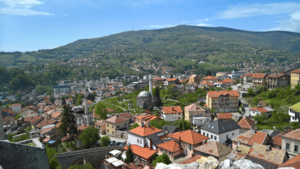Travnik facts for kids
Quick facts for kids
Travnik
Травник
|
||
|---|---|---|
|
Town and municipality
|
||
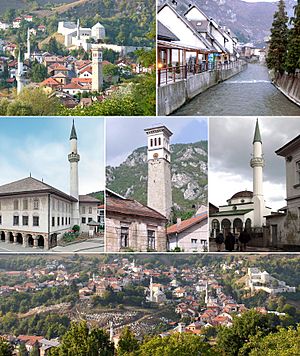
Travnik
|
||
|
||
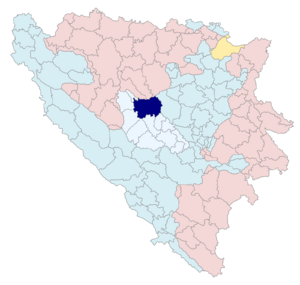
Location of Travnik Municipality within Bosnia and Herzegovina.
|
||
| Country | ||
| Entity | Federation of Bosnia and Herzegovina | |
| Canton | ||
| Area | ||
| • Town and municipality | 529 km2 (204 sq mi) | |
| Elevation | 514 m (1,686 ft) | |
| Population
(2013 census)
|
||
| • Density | 101.10/km2 (261.8/sq mi) | |
| • Urban | 15,344 | |
| • Municipality | 53,482 | |
| Time zone | UTC+1 (CET) | |
| • Summer (DST) | UTC+2 (CEST) | |
| Postal code |
72270
|
|
| Area code(s) | +387 30 | |
Travnik (Cyrillic: Травник) is a town and a municipality in Bosnia and Herzegovina. It is the administrative center of the Central Bosnia Canton of the Federation of Bosnia and Herzegovina. It is situated in central Bosnia and Herzegovina, 90 kilometres (56 miles) west of Sarajevo. As of 2013[update] the town had a population of 15,344 inhabitants, while the municipality had 53,482 inhabitants.
Historically, it was the capital city of the governors of Bosnia from 1699 to 1850, and has a cultural heritage dating from that period.
Contents
Geography
Travnik is located near the geographic center of Bosnia and Herzegovina at 44°14′N 17°40′E / 44.233°N 17.667°E. The river Lašva passes through the town, flowing from west to east before joining the Bosna. Travnik itself is built in the large Lašva valley, which connects the Bosna river valley in the east with the Vrbas river valley in the west.
Travnik is found 514 metres (1,686 feet) above sea level. Its most distinguishing geographic feature are its mountains, Vilenica and Vlašić. Vlašić, named after the Vlachs, is one of the tallest mountains in the country at 1,933 metres (6,342 feet).
A large karst spring, the Plava Voda wellspring, rises under Vlašić mountain, just below Travnik Castle, in the very center of the Old Town of Travnik.
Climate
Travnik has a continental climate, located between the Adriatic sea to the South and Pannonia to the North. Average July temperature is 19.0 °C (66.2 °F). Average January temperature on the other hand is −1.0 °C (30.2 °F). It snows in Travnik every year.
| Climate data for Travnik | |||||||||||||
|---|---|---|---|---|---|---|---|---|---|---|---|---|---|
| Month | Jan | Feb | Mar | Apr | May | Jun | Jul | Aug | Sep | Oct | Nov | Dec | Year |
| Daily mean °C (°F) | −1.0 (30.2) |
0.6 (33.1) |
3.9 (39.0) |
8.6 (47.5) |
13.3 (55.9) |
17.0 (62.6) |
19.0 (66.2) |
18.9 (66.0) |
14.3 (57.7) |
9.6 (49.3) |
4.8 (40.6) |
−0.2 (31.6) |
9.1 (48.3) |
| Average precipitation mm (inches) | 63.9 (2.52) |
68.9 (2.71) |
59.3 (2.33) |
76.8 (3.02) |
94.9 (3.74) |
91.2 (3.59) |
87.5 (3.44) |
69.6 (2.74) |
106.8 (4.20) |
94.4 (3.72) |
111.4 (4.39) |
106.2 (4.18) |
1,030.9 (40.58) |
| Average rainy days | 6 | 7 | 11 | 16 | 15 | 13 | 10 | 11 | 10 | 12 | 10 | 8 | 129 |
| Average snowy days | 10 | 9 | 7 | 3 | 0 | 0 | 0 | 0 | 0 | 1 | 4 | 9 | 43 |
| Average dew point °C (°F) | −4 (25) |
−2 (28) |
0 (32) |
2 (36) |
7 (45) |
11 (52) |
12 (54) |
11 (52) |
10 (50) |
6 (43) |
0 (32) |
−2 (28) |
4 (40) |
| Source 1: Climate Charts(temperatures-precipitation 1993-2022) | |||||||||||||
| Source 2: unipage.net(Rain and snow days-dew point) | |||||||||||||
History
Although there is evidence of some settlement in the region dating back to the Bronze Age, the true history of Travnik begins during the first few centuries AD. Dating from this time there are numerous indications of Roman settlement in the region, including graves, forts, the remains of various other structures, early Christian basilicas, etc. In the town itself, Roman coins and plaques have been found. Some writing found indicates the settlement is closely connected to the known Roman colony in modern-day Zenica, 30 km (19 mi) away.
In the Middle Ages the Travnik area was known as the župa Lašva, a province of the medieval Bosnian Kingdom. The area is first mentioned by Bela IV of Hungary in 1244. Travnik itself was one of a number of fortified towns in the region, with its fortress Kaštel becoming today's old town sector. The town itself is first mentioned by the Ottomans during their conquest of nearby Jajce.
After the Ottoman conquest of Bosnia in the 15th century, much of the local population converted to Islam as part of the Islamization policy by the Ottoman Empire. The town quickly grew into one of the more important settlements in the region, as the authorities constructed mosques, marketplaces, and various infrastructures. During 1699 when Sarajevo was set afire by the soldiers of Field-Marshal Prince Eugene of Savoy, Travnik became the capital of the Ottoman province of Bosnia and residence of the Bosnian viziers. The town became an important center of government in the entire western frontier of the empire, and consulates were established by the governments of France and Austria-Hungary.
The period of Austrian occupation brought westernization and industry to Travnik, but also a reduction of importance. While cities such as Banja Luka, Sarajevo, Tuzla, and Zenica grew rapidly, Travnik changed so little that during 1991 it had a mere 30,000 or so people, with 70,000 in the entire municipality.
A large fire started by a spark from a locomotive in September 1903 destroyed most of the town's buildings and homes, leaving only some hamlets and the fortress untouched. The cleanup and rebuilding took several years.
From 1922 to 1929, Travnik was the capital of the Travnik Oblast. From 1929 to 1941, Travnik was part of the Drina Banovina of the Kingdom of Yugoslavia.
During the Bosnian War, the town mostly escaped damage from conflict with Serbian forces, hosting refugees from nearby Jajce, but the area experienced fighting between local Bosniak and Croat factions before the Washington Agreement was signed in 1994. After the war, Travnik was made the capital of the Central Bosnia Canton.
Administration
Travnik is the administrative centre of the Municipality of Travnik, whose area of jurisdiction covers the town of Travnik itself and 89 other rural settlements. Travnik is also the capital of the Central Bosnia Canton, one of the ten Cantons of Bosnia. The municipal government has various agencies dedicated to the operations of the region, ranging from the bureau of urbanization and construction, to the bureau of refugees and displaced persons.
| Party | Number of representatives | Current number of representatives | ||||||||||||||
|---|---|---|---|---|---|---|---|---|---|---|---|---|---|---|---|---|
| 2000. | 2004. | 2008. | 2012. | |||||||||||||
| SDA |
14 / 31
|
15 / 31
|
11 / 31
|
|||||||||||||
| SDP BiH |
6 / 25
|
2 / 25
|
2 / 25
|
5 / 25
|
||||||||||||
| HDZ BiH |
7 / 31
|
6 / 31
|
8 / 31
|
4 / 31
|
||||||||||||
| SBB BiH |
4 / 31
|
|||||||||||||||
| HDZ 1990 |
0 / 31
|
2 / 31
|
||||||||||||||
| HSS-NHI |
2 / 31
|
1 / 31
|
1 / 31
|
1 / 31
|
||||||||||||
| HSS SR |
1 / 31
|
|||||||||||||||
| LDS BiH |
1 / 31
|
0 / 31
|
1 / 31
|
|||||||||||||
| Sources: | ||||||||||||||||
Economy
The economy of the Travnik region suffered greatly during the war period of the early 1990s. In 1981 Travnik's GDP per capita was 63% of the Yugoslav average. Nowadays, most of the region deals with typical rural work such as farming and herding. As for the urban industry, Travnik has several factories producing everything from matches to furniture. Food processing is also a strong industry in the region, especially meat and milk companies.
Tourism
Like many Bosnian towns, Travnik's tourism is based largely on its history and geography. Nearby Mount Vlašić is one of the tallest peaks in Bosnia and Herzegovina, and an excellent spot for skiing, hiking and sledding. Whilst tourism is not very strong for the town, Mount Vlašić is probably its chief tourist attraction. Numerous structures dating to the Ottoman era have survived in near perfect condition, such as numerous mosques, oriental homes, two clock towers (sahat kula; Travnik is the only town in Bosnia and Herzegovina to have two clock towers) and fountains. The old town dates back to the early 15th century, making it one of the most popular and widely accessible sites from that time.
Demographics
Population
| Population of settlements – Travnik municipality | |||||
|---|---|---|---|---|---|
| Settlement | 1971 | 1981 | 1991 | 2013 | |
| Total | 55,822 | 64,100 | 70,747 | 53,482 | |
| 1 | Bačvice | 747 | 574 | ||
| 2 | Bijelo Bučje | 924 | 707 | ||
| 3 | Bilići | 335 | 287 | ||
| 4 | Brajići | 625 | 628 | ||
| 5 | Brajkovići | 521 | 394 | ||
| 6 | Brankovac | 298 | 255 | ||
| 7 | Čosići | 683 | 433 | ||
| 8 | Čukle | 1,348 | 524 | ||
| 9 | Đelilovac | 1,229 | 777 | ||
| 10 | Dolac | 700 | 480 | ||
| 11 | Dolac na Lašvi | 504 | 456 | ||
| 12 | Donje Krčevine | 497 | 317 | ||
| 13 | Dub | 962 | 988 | ||
| 14 | Gladnik | 330 | 332 | ||
| 15 | Gluha Bukovica | 1,041 | 878 | ||
| 16 | Goleš | 1,081 | 425 | ||
| 17 | Gornje Krčevine | 759 | 576 | ||
| 18 | Gradina | 609 | 383 | ||
| 19 | Grahovčići | 1,215 | 403 | ||
| 20 | Grahovik | 342 | 277 | ||
| 21 | Guča Gora | 847 | 511 | ||
| 22 | Hamandžići | 501 | 256 | ||
| 23 | Han Bila | 682 | 655 | ||
| 24 | Jezerci | 643 | 338 | ||
| 25 | Kljaci | 739 | 634 | ||
| 26 | Krpeljići | 722 | 629 | ||
| 27 | Kula | 450 | 528 | ||
| 28 | Maline | 1,483 | 1,095 | ||
| 29 | Mosor | 319 | 265 | ||
| 30 | Mudrike | 748 | 550 | ||
| 31 | Nova Bila | 770 | 692 | ||
| 32 | Orahovo | 399 | 328 | ||
| 33 | Ovčarevo | 564 | 496 | ||
| 34 | Paklarevo | 1,258 | 975 | ||
| 35 | Podkraj | 462 | 507 | ||
| 36 | Podovi | 1,039 | 1,076 | ||
| 37 | Podstinje | 722 | 538 | ||
| 38 | Pokrajčići | 1,378 | 1,540 | ||
| 39 | Poljanice | 296 | 250 | ||
| 40 | Polje Slavka Gavrančića | 415 | 344 | ||
| 41 | Pulac | 498 | 417 | ||
| 42 | Putićevo | 1,523 | 1,193 | ||
| 43 | Radića Brdo | 315 | 230 | ||
| 44 | Radojčići | 293 | 312 | ||
| 45 | Ričice | 653 | 584 | ||
| 46 | Seferi | 527 | 417 | ||
| 47 | Selići | 448 | 302 | ||
| 48 | Šipovik | 352 | 202 | ||
| 49 | Slimena | 934 | 1,231 | ||
| 50 | Suhi Dol | 576 | 482 | ||
| 51 | Travnik | 12,977 | 15,888 | 19,041 | 16,534 |
| 52 | Turbe | 4,549 | 3,890 | ||
| 53 | Turići | 795 | 650 | ||
| 54 | Varošluk | 736 | 693 | ||
| 55 | Višnjevo | 967 | 958 | ||
| 56 | Vitovlje | 708 | 576 | ||
| 57 | Vlahovići | 344 | 309 | ||
| 58 | Zagrađe | 631 | 447 | ||
Ethnic composition
| Ethnic composition – Travnik town | |||||||
|---|---|---|---|---|---|---|---|
| 2013 | 1991 | 1981 | 1971 | ||||
| Total | 15,344 (100,0%) | 19,041 (100,0%) | 15,888 (100,0%) | 12,977 (100,0%) | |||
| Bosniaks | 10,899 (71,03%) | 7,373 (38,72%) | 5,822 (36,64%) | 5,730 (44,16%) | |||
| Croats | 2,847 (18,55%) | 6,043 (31,74%) | 5,026 (31,63%) | 4,538 (34,97%) | |||
| Others | 1,276 (8,316%) | 694 (3,645%) | 89 (0,560%) | 122 (0,940%) | |||
| Serbs | 322 (2,09%) | 2,131 (11,19%) | 1,901 (11,97%) | 1,894 (14,60%) | |||
| Yugoslavs | 2,800 (14,71%) | 2 867 (18,05%) | 486 (3,745%) | ||||
| Montenegrins | 89 (0,560%) | 102 (0,786%) | |||||
| Albanians | 48 (0,302%) | 30 (0,231%) | |||||
| Slovenes | 30 (0,189%) | 44 (0,339%) | |||||
| Macedonians | 9 (0,057%) | 21 (0,162%) | |||||
| Hungarians | 7 (0,044%) | 10 (0,077%) | |||||
| Ethnic composition – Travnik municipality | |||||||
|---|---|---|---|---|---|---|---|
| 2013 | 1991 | 1981 | 1971 | ||||
| Total | 53,482 (100,0%) | 70,747 (100,0%) | 64,100 (100,0%) | 55,822 (100,0%) | |||
| Bosniaks | 35,648 (66,65%) | 31,813 (44,97%) | 27,691 (43,20%) | 24,480 (43,85%) | |||
| Croats | 15,102 (28,24%) | 26,118 (36,92%) | 24,411 (38,08%) | 22,645 (40,57%) | |||
| Others | 2,092 (3,912%) | 1,296 (1,832%) | 325 (0,507%) | 246 (0,441%) | |||
| Serbs | 640 (1,197%) | 7,777 (10,99%) | 7,487 (11,68%) | 7,554 (13,53%) | |||
| Yugoslavs | 3,743 (5,291%) | 3,920 (6,115%) | 626 (1,121%) | ||||
| Montenegrins | 126 (0,197%) | 133 (0,238%) | |||||
| Albanians | 63 (0,098%) | 36 (0,064%) | |||||
| Slovenes | 32 (0,050%) | 49 (0,088%) | |||||
| Macedonians | 22 (0,034%) | 25 (0,045%) | |||||
| Roma | 16 (0,025%) | 18 (0,032%) | |||||
| Hungarians | 7 (0,011%) | 10 (0,018%) | |||||
Culture
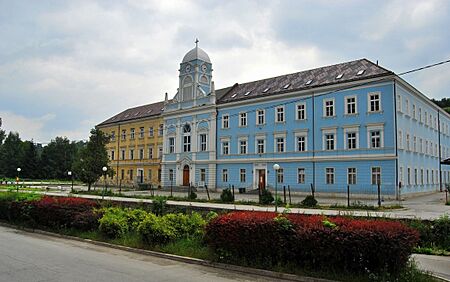

Travnik has a strong culture, mostly dating back to its time as the center of the local government in the Ottoman Empire. Travnik has a popular old town district, which dates back to the period of Bosnian independence during the first half of the 15th century. Numerous mosques and churches exist in the region, as do tombs of important historical figures and excellent examples of Ottoman architecture. The town museum, built in 1950, is one of the most impressive cultural institutions in the region.
One of the main works of Ivo Andrić, a native of Travnik, is the Bosnian Chronicle (or the Travnik Chronicle), depicting life in Travnik during the Napoleonic Wars and written during World War II.
The Bosnian Tornjak, one of Bosnia's two major dog breeds and a national symbol, originated in the area, and can be found around the Vlašić mountain.
Sports
The local football team is NK Travnik, founded in 1922.
Transport
Rail
Travnik, like the Central Bosnia Canton, currently has no rail links. In the past, the city was served by a narrow-gauge railway which has since been abandoned.
Notable people
- Ivo Andrić, writer and the 1961 winner of the Nobel Prize in Literature
- Miroslav Ćiro Blažević, professional football manager and player
- Muharem Bazdulj, Bosnian novelist and journalist.
- Nura Bazdulj-Hubijar, Bosnian poet and novelist.
- Brothers Josip and Zlatko Pejaković, artists, actors, and musicians
- Davor Džalto, artist, art historian, theologian, and philosopher
- Nikša Bratoš, composer and arranger of contemporary music
- Oliver Frljić, theatre director
- Vjekoslav Kramer, chef
- Sena Jurinac, operatic soprano
- Solomon Gaon, Sephardic Rabbi and Hakham
- Mirosław Ferić, fighter pilot
- Nikola Mandić, politician
- Zlata Bartl, scientist and is the creator of Vegeta
- Frano Zubić, Bosnian Franciscan
- Larisa Cerić, judoka and European Championship silver medalist
- Mladen Solomun, DJ and music producer
- Vildana Selimbegović, journalist and editor of Oslobođenje
Twin towns – sister cities
Travnik is twinned with:
Gallery
-
Birthplace (home) of Ivo Andrić
See also
 In Spanish: Travnik para niños
In Spanish: Travnik para niños



